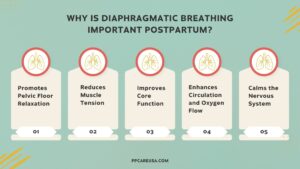Whether you’re weeks or months postpartum, your body is still adjusting to the major shifts of pregnancy and childbirth. One surprisingly powerful tool to support your healing is something you do all day without thinking—breathing. Specifically, diaphragmatic breathing, which is also known as “belly breathing” or “piston breathing,” can help restore core function, reduce pelvic floor tension, and calm your nervous system.
If you’ve never been taught how to breathe with intention—or if you’ve been chest breathing without realizing it—this blog post will walk you through why diaphragmatic breathing matters and how to practice it safely and effectively.
What Happens to the Diaphragm During Pregnancy?
During pregnancy, everything inside your body gets “pushed around” to make room for your growing baby—including your diaphragm, the dome-shaped muscle located just beneath your ribcage. As your uterus expands upward, the diaphragm has less space to move, often becoming inhibited or underused.
After birth, many women continue breathing from their chest, a pattern that can persist for months or even years if not addressed. This kind of shallow, upper-chest breathing tends to tighten the abdominal muscles and pelvic floor, contributing to issues like pelvic pain, urinary incontinence, back pain, and even anxiety.
What Is Diaphragmatic Breathing?
Diaphragmatic breathing is a technique that re-engages your diaphragm, allowing you to breathe deeply and efficiently. When done properly, the diaphragm expands downward as you inhale, gently moving your abdominal organs and encouraging relaxation of the pelvic floor muscles. On the exhale, everything recoils naturally, helping restore the rhythm between your breathing and your core.
That’s why this is often called “piston breathing”—the diaphragm and pelvic floor move in sync like a piston system. This gentle, coordinated movement is the foundation for core stability and pelvic floor health.
Why Is Diaphragmatic Breathing So Important Postpartum?
Breathing from the diaphragm does more than just improve oxygen intake. For postpartum recovery, it offers a wide range of physical and emotional benefits:
✔️ Promotes Pelvic Floor Relaxation
Tight pelvic floor muscles can lead to discomfort, pain with intimacy, constipation, and other symptoms. Diaphragmatic breathing encourages a natural release of these muscles.
✔️ Reduces Muscle Tension
Tension in your shoulders, neck, back, and even glutes can often be traced back to poor breathing habits. Re-establishing diaphragmatic breathing helps relieve this tension and supports a more balanced posture.
✔️ Improves Core Function
Because breathing is so closely linked to how your deep core muscles function, retraining your diaphragm can enhance abdominal strength, especially when combined with pelvic floor physical therapy.
✔️ Enhances Circulation and Oxygen Flow
Deeper breaths increase oxygen and blood flow to your tissues, aiding healing and reducing the risk of injury.
✔️ Calms the Nervous System
Perhaps most importantly, diaphragmatic breathing activates the parasympathetic nervous system, helping you shift out of stress mode, reduce anxiety, and sleep better. For new moms, that’s no small thing.

How to Practice Diaphragmatic Breathing
You can begin this gentle practice as soon as it feels comfortable postpartum. If you’ve had a C-section or complicated birth, be sure to consult with your healthcare provider or pelvic floor physical therapist before beginning.
Here’s a step-by-step guide:
- Lie on your back (knees bent or straight—whatever feels best to you).
- Place one hand on your chest and the other on your belly.
- Inhale slowly through your nose. Focus on sending the breath down into your belly. Your lower hand should rise gently while your upper hand remains mostly still.
- Exhale softly through pursed lips (as if blowing out a candle). Feel your belly slowly fall.
- Repeat: Inhale—belly rises. Exhale—belly falls.
- Use a count to guide your pace: Try breathing in for a count of 3, and exhaling for a count of 5.
- Aim for 5 minutes of practice, especially in the evening before bed.
You might also play calming music or use a meditation app to help you focus. Practicing this regularly can create noticeable changes in how your body feels and functions.
Real Talk: It Might Feel Weird at First
If your diaphragm hasn’t been doing much lately, diaphragmatic breathing might feel unnatural at first—and that’s okay. Like any muscle, the diaphragm needs to be retrained. Start small, stay consistent, and don’t worry if it takes time to feel comfortable.
As a pelvic floor physical therapist, I always begin with breathwork when working with postpartum clients. It’s not just about relaxation—it’s the gateway to rebuilding core strength, pelvic floor function, and even confidence in your body again.
Breathe Better, Heal Better
Postpartum recovery doesn’t have to feel like a mystery. Sometimes, the simplest acts—like breathing—can have the biggest impact. By reconnecting with your diaphragm, you can lay the groundwork for long-term healing, strength, and resilience.
If you’re struggling with postpartum symptoms or just want support in your recovery, a pelvic floor physical therapist can guide you through breathwork and beyond.
Pin This for Later:




Dr. Amanda Thompson, PT, DPT is a pelvic floor physical therapist dedicated to helping women heal, move, and thrive. With advanced training from the Institute for Birth Healing and the Integrative Women’s Health Institute, along with degrees from Texas A&M University and the University of North Texas Health Science Center, she specializes in postpartum recovery, pelvic floor dysfunction, and core rehabilitation.
As the founder of Rooted Physical Therapy, LLC in Bridgeport, TX, Dr. Thompson and her team have helped hundreds of women resolve pelvic pain, incontinence, and core weakness so they can return to active, pain-free lives. She offers both in-person and virtual visits, making expert pelvic floor care more accessible.
For more information, visit: https://www.rootedphysicaltherapyllc.com/
Postnatal Depletion
Meet the Team
Our Services
Supplements
A virtual healthcare clinic that helps postpartum mamas recover from postnatal depletion syndrome with a holistic approach.

Get in touch